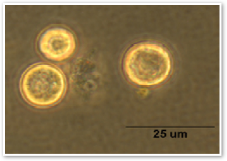Prochloron didemni
A Microbial Biorealm page on the genus Prochloron didemni
Classification
Higher order taxa
Cellular Organisms; Bacteria; Cyanobacteria; Prochlorales; Prochloraceae; Prochloron
Species
|
NCBI: Taxonomy |
Prochloron Didemni
Description and significance
Prochloron Didemni is a unicellular cyanobacteria that is photosynthetic and oxygenic. It is an obligate symbiont that lives in the ascidian Lissoclinum patella and can be found in marine environments.
The study of Prochloron didemni and its genome can provide us with valuable information. The genome of P. didemni is currently incomplete. However, when completed, P. didemni's genome can be used for analysis to elucidate other genes responsible for symbiosis between bacteria and chordates, such as humans. Also, as a oxygenic, photosynthetic cyanobacteria, P. didemni is a significant player in global carbon fixation. The study of its metabolic pathways and unique photosynthetic processes would yield information beneficial to biotechnology.
R.A. Lewin first discovered Prochloron didemni in 1975, but identified it as Synechocystis didemni. In 1977, the presence of chlorophyll a/b and the lack of phycobilins caused it to be transfered to a new genus, Prochloron, and named Prochloron didemni.(4)
Genome structure
Describe the size and content of the genome. How many chromosomes? Circular or linear? Other interesting features? What is known about its sequence? Does it have any plasmids? Are they important to the organism's lifestyle?
Cell structure and metabolism
Describe any interesting features and/or cell structures; how it gains energy; what important molecules it produces.
Ecology
Prochloron didemni is an obligate symbiont that lives in the ascidian Lissoclinum patella. L. patella along with P. didemni can be found in tropical waters, such as the reefs in Hawaii and the Great Barrier Reef in Australia.(2,7)
Exchange of nutrients is the main reason for the symbiotic relationship between L. patella and P. didemni. Photosynthesis by P. didemni provides 60-100% of the organic carbon needed by L. patella. There is also evidence that suggests there is nitrogen cycling between the host and symbiont as well as nitrogen fixation. In exchange for the organic carbons and nitrogen cycling, L. patella provides optimal growth conditions by moving to areas with proper sunlight and a tunic covering.(1)
Application to Biotechnology
Patellamides A and C
Does this organism produce any useful compounds or enzymes? What are they and how are they used?
Current Research
Enter summaries of the most recent research here--at least three required
References
Edited by Edward Lee Eddie Lee, a student of Rachel Larsen Rachel Larsen



